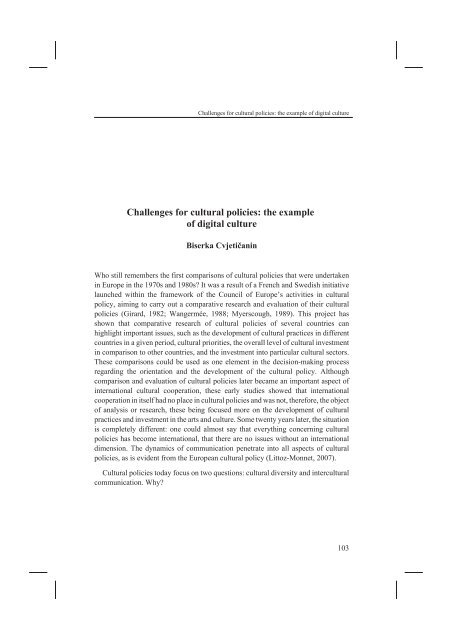D:\Documents and Settings\Ana\My Documents\Biserka-knjiga ...
D:\Documents and Settings\Ana\My Documents\Biserka-knjiga ...
D:\Documents and Settings\Ana\My Documents\Biserka-knjiga ...
You also want an ePaper? Increase the reach of your titles
YUMPU automatically turns print PDFs into web optimized ePapers that Google loves.
Challenges for cultural policies: the example of digital culture<br />
Challenges for cultural policies: the example<br />
of digital culture<br />
Biserka Cvjetièanin<br />
Who still remembers the first comparisons of cultural policies that were undertaken<br />
in Europe in the 1970s <strong>and</strong> 1980s? It was a result of a French <strong>and</strong> Swedish initiative<br />
launched within the framework of the Council of Europe’s activities in cultural<br />
policy, aiming to carry out a comparative research <strong>and</strong> evaluation of their cultural<br />
policies (Girard, 1982; Wangermée, 1988; Myerscough, 1989). This project has<br />
shown that comparative research of cultural policies of several countries can<br />
highlight important issues, such as the development of cultural practices in different<br />
countries in a given period, cultural priorities, the overall level of cultural investment<br />
in comparison to other countries, <strong>and</strong> the investment into particular cultural sectors.<br />
These comparisons could be used as one element in the decision-making process<br />
regarding the orientation <strong>and</strong> the development of the cultural policy. Although<br />
comparison <strong>and</strong> evaluation of cultural policies later became an important aspect of<br />
international cultural cooperation, these early studies showed that international<br />
cooperation in itself had no place in cultural policies <strong>and</strong> was not, therefore, the object<br />
of analysis or research, these being focused more on the development of cultural<br />
practices <strong>and</strong> investment in the arts <strong>and</strong> culture. Some twenty years later, the situation<br />
is completely different: one could almost say that everything concerning cultural<br />
policies has become international, that there are no issues without an international<br />
dimension. The dynamics of communication penetrate into all aspects of cultural<br />
policies, as is evident from the European cultural policy (Littoz-Monnet, 2007).<br />
Cultural policies today focus on two questions: cultural diversity <strong>and</strong> intercultural<br />
communication. Why?<br />
103



